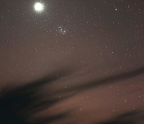Governing the Planets

FOR THE ENTIRETY OF HUMAN CIVILISATION, roughly 6,000 years, most of the stars in the nighttime sky have seemingly retained the same relative positions. The stars are so far from us, and in most cases one another, that the motions we now know they possess are almost insignificant. Coupled with the ‘fixed’ stellar background and easily noticeable to the earliest watchers of the heavens are five bright celestial dots of light — Mercury, Venus, Mars, Jupiter and Saturn — which, like the Moon, move about in predictable yet at times complex ways. By 400 BCE, and possibly as early as the 6th century BCE, the ancient Greeks were articulating interpretations of their observations of the five objects, which they named plane¯te¯s, meaning ‘wanderer,’ from which the English word planet is derived. Underlying assumptions, promulgated chiefly by Aristotle (384–322 BCE), were that all cosmic motions are circular and uniform, that the cosmos beyond the Moon is a finite, spherical, eternal and changeless model of perfection, and that Earth occupies the centre of the unchanging sphere, thereby implying that the planets revolve around us.
Contrary to the order inferred by Aristotle’s suppositions was the puzzling observed ‘retrograde motion,’ occurring when the outer planets, Mars, Jupiter and Saturn, are at — opposite in the sky from the Sun when viewed from Earth — and temporarily appear to reverse course. Generally the outer planets move eastward with respect to the stars, but as the more rapidly orbiting Earth passes on
You’re reading a preview, subscribe to read more.
Start your free 30 days





